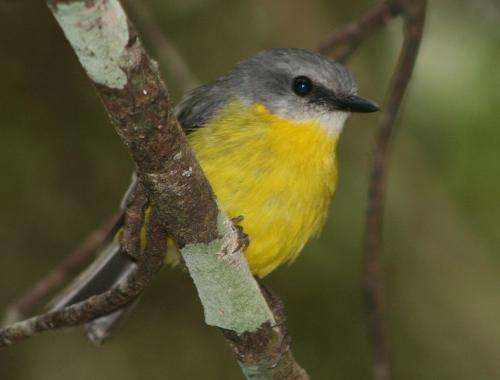August 26, 2015 report
Study shows nesting under white lights causes increased hormone levels in songbirds

(Phys.org)—A small team of researchers with members from The Netherlands Institute of Ecology, the Max Planck Institute for Ornithology and Wageningen University has found that wild great tits living under street lights that emit white light have higher than normal amounts of the stress hormone corticosterone in their blood. In their paper published in Royal Society – Biology Letters, the group describes the field studies they carried out, what they learned and offer suggestions for ways to protect wildlife from the damaging impact of light pollution.
Many studies have been carried out that show that unnatural light has an impact on wild animals—sea turtles have been found to swim towards shore, for example, rather than out to sea, birds crash into streetlights and buildings, songbirds alter their tunes and some migrating birds get distracted and lose their way. In this new effort, the researchers sought to learn more about the impact on nesting great tits—a type of woodland songbird that lives in many parts of Europe, the Middle East and parts of Asia and Africa.
To learn more, the researchers set up nesting boxes in nine areas around lampposts that had different types of bulbs in them to emit red, green or white light. Another similar area with no lighting was used as a control. Birds were captured and released in each of the nesting boxes and blood samples were taken—tests were then conducted in a lab to determine corticosterone (a hormone that is known to be elevated during times of stress) levels.
In studying the blood samples, the researchers found that the birds that nested under white lights had higher corticosterone levels than other birds that nested under green lights or in the dark. They also found that the closer the birds nested to the white light, the higher their levels of the stress hormone. Also, those that nested near the red lamps had levels as high as those that nested under the white lights but the impact grew less faster as the distance from the light increased. They found also that the heightened hormone levels did not decrease the number of birds that had offspring but did cause a decrease in the numbers that hatched.
The researchers suggest their results indicate that it might be possible to lessen the impact of light pollution on wildlife by altering the type of light used in urban areas.
More information: Stressful colours: corticosterone concentrations in a free-living songbird vary with the spectral composition of experimental illumination, Biology Letters, DOI: 10.1098/rsbl.2015.0517
Journal information: Biology Letters
© 2015 Phys.org















